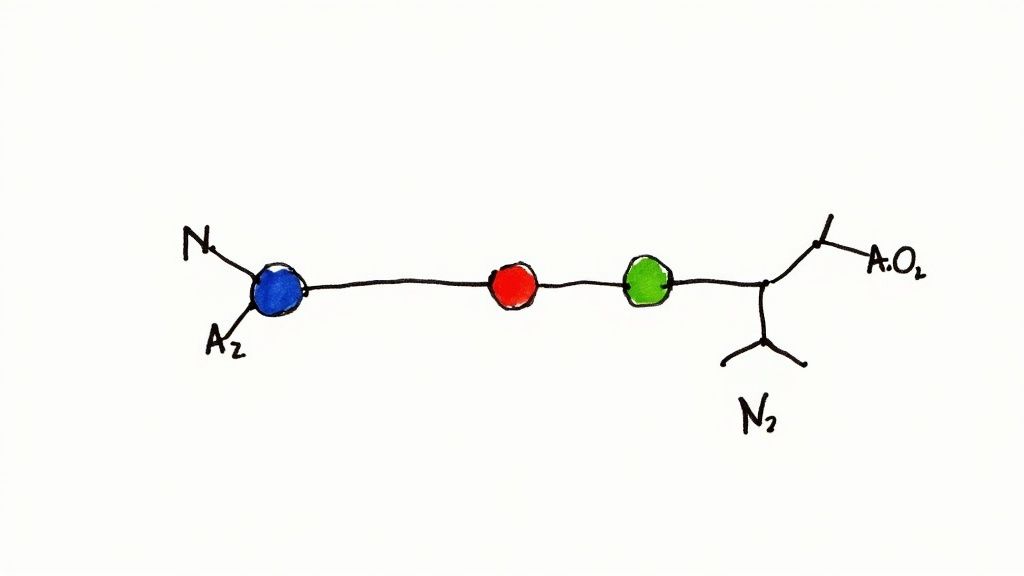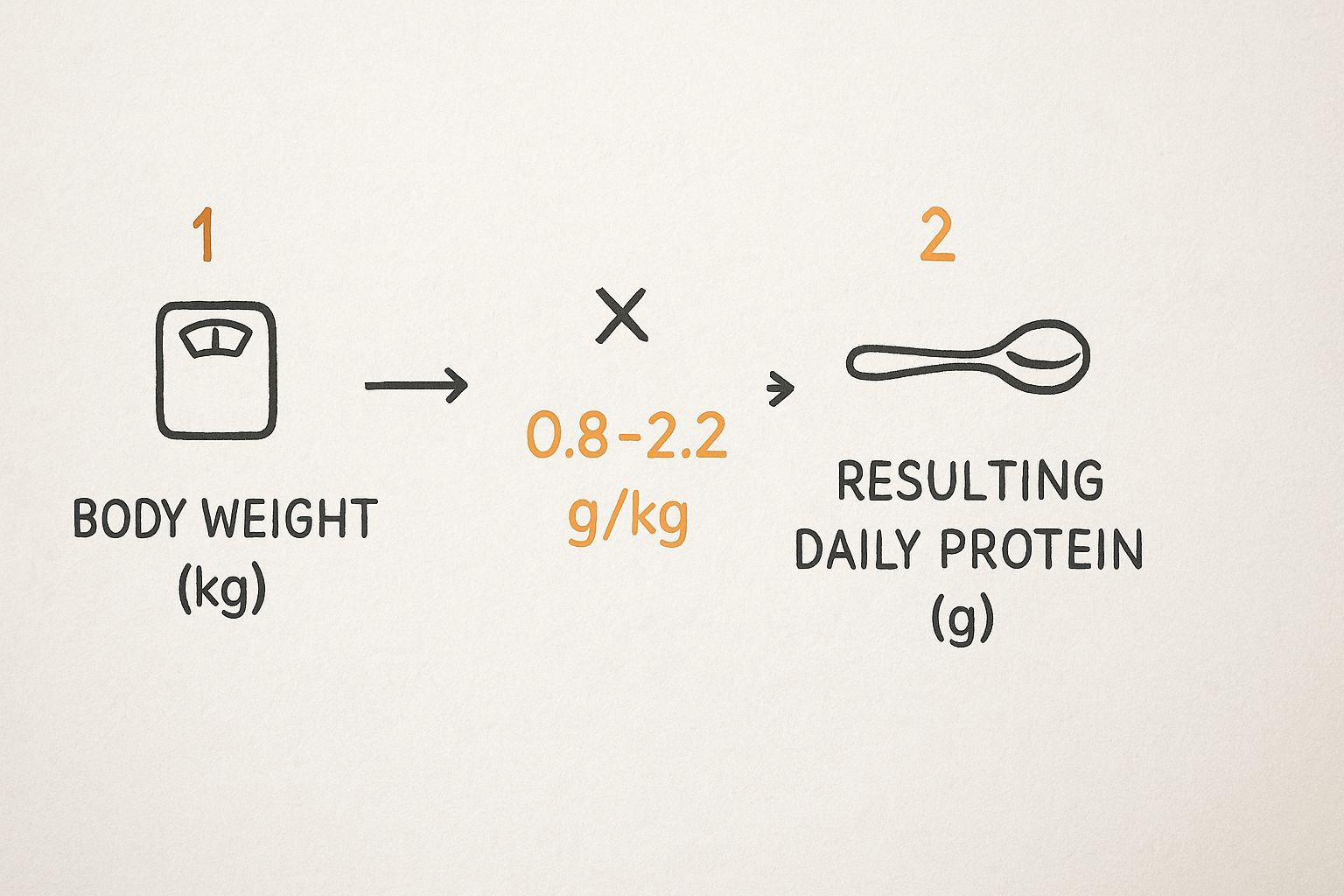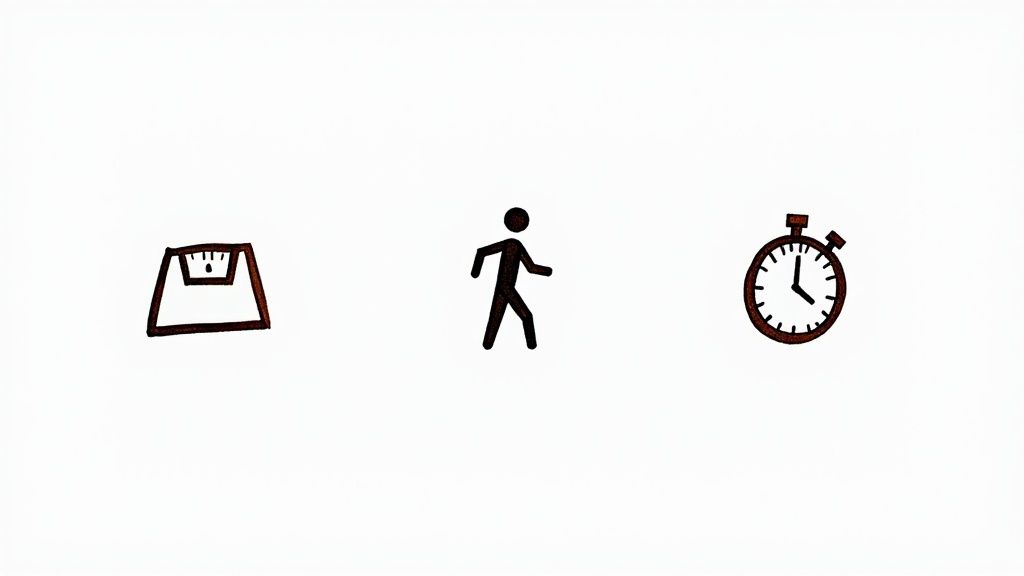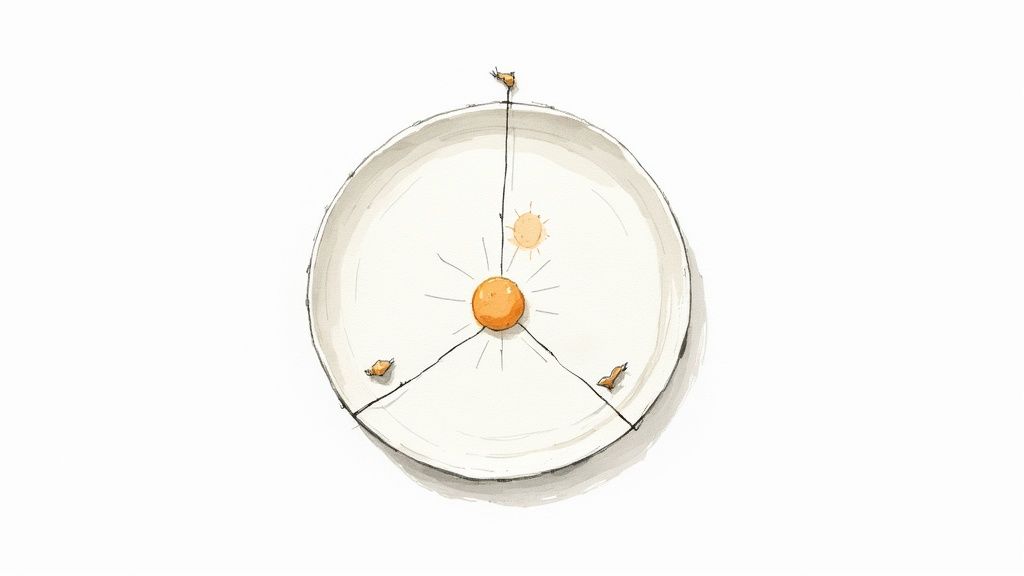How to Calculate Daily Protein Needs Without The Math
Tired of confusing formulas? Learn how to calculate daily protein needs with our simple, practical guide for busy people. No diet obsession, just easy tips.
Posted by
Figuring out your personal protein target can feel a bit like a pop quiz you didn't study for. Don't worry, the basic math is actually pretty simple and relies mostly on your body weight. You don't need a PhD in nutrition to nail this down.
Let's figure out a good protein goal for you, without the stress.
Your Simple Guide To Protein Needs

Let's cut right to it. Finding your daily protein number isn't some complex, overwhelming task. Think of protein as your body's repair crew. It’s essential for building and maintaining muscle, but it also plays a huge role in keeping you full and satisfied between meals.
Your ideal protein intake isn't a static number, either. It’s a moving target that changes with your lifestyle, how active you are, and what you're trying to achieve. Someone training for a marathon obviously needs more protein than someone who works a desk job and enjoys light walks on the weekend.
Finding a Starting Point
So, where do you even start? The most common guideline, backed by major health organizations, is the perfect, no-fuss place to begin. This is the Recommended Dietary Allowance (RDA), which sets the baseline at 0.8 grams of protein per kilogram of body weight. This is the minimum you need to meet your basic nutritional requirements if you're not very active. For a deeper dive into the science, you can check out some of the research here.
To get a quick estimate, just follow these two steps:
- First, get your weight in kilograms: Take your weight in pounds and divide it by 2.2.
- Then, find your baseline protein: Multiply that kilogram number by 0.8.
Let's use a real-world example. Say you weigh 150 pounds. That’s about 68 kilograms (150 / 2.2). Multiply 68 by 0.8, and you get a baseline target of roughly 54 grams of protein per day.
To make it even easier, here’s a quick reference table.
Quick Protein Needs Snapshot
This table gives you a simple look at the baseline protein needs for different body weights based on the standard RDA.
| Your Weight (lbs) | Your Weight (kg) | Baseline Protein Goal (grams) |
|---|---|---|
| 120 | 54.5 | ~44 |
| 140 | 63.6 | ~51 |
| 160 | 72.7 | ~58 |
| 180 | 81.8 | ~65 |
| 200 | 90.9 | ~73 |
Remember, these numbers represent the minimum for a non-active person. If you're exercising regularly, your needs will probably be higher.
Keep in mind: This baseline is just that—a starting point. As we’ll get into, you’ll likely want to adjust this number upward based on your activity level and fitness goals.
The idea isn't to hit a precise number on the dot every single day. It's more about being consistently mindful of your intake. This is where a more relaxed approach to tracking, like simply talking to an app, can help you stay aware without all the stress.
Finding Your Personal Protein Number
Alright, that baseline number is a solid start, but let’s be real—your life isn’t a baseline. Your actual protein needs are tied directly to how you move throughout your day.
Are you mostly at a desk, or are you chasing kids around and constantly on your feet? Do you hit the gym for some serious lifting a few times a week, or is your activity more like a long hike on the weekend? The trick is to match your protein intake to your lifestyle, and thankfully, it's not complicated.
This infographic gives a great visual of how this works.

The core idea is simple: your body weight multiplied by an "activity factor." The only thing you need to figure out is which multiplier fits you best.
Adjusting for Your Activity Level
Think of it this way: someone who walks across a college campus every day has different demands than a professional who bikes to work. Both are active, but their protein requirements will differ.
For sedentary adults, the standard recommendation is 0.8 grams per kilogram of body weight. But once you start adding regular physical activity, that number needs to go up.
Moderately active people should aim for 1.1 to 1.5 grams of protein per kilogram daily. If you're really pushing it with strength training, that number climbs to 1.2 to 1.7 grams per kilogram to help your muscles repair and grow.
Here’s a quick guide to find your multiplier:
- Mostly Chilling (Sedentary): You spend most of your day sitting. The baseline of 0.8 g/kg is a good fit.
- Lightly Active: You get in a daily walk or have a job that keeps you moving. Aim for 1.0 to 1.2 g/kg.
- Moderately Active: You're in the gym a solid 3-4 times a week. A multiplier of 1.2 to 1.5 g/kg is your sweet spot.
- Very Active: You’re into heavy lifting, serious endurance training, or have a physically demanding job. Go for 1.5 to 1.7 g/kg.
The Takeaway: You don't need a complex formula. Just be honest about your activity level, pick the category that sounds most like you, and use that multiplier. It's a flexible approach that you can easily adjust as your routine changes.
Getting your protein right is just one piece of the puzzle. It works hand-in-hand with your total energy intake. If you want to dial in the other side of the equation, take a look at our guide on how to calculate your daily calorie needs.
What Your Protein Number Means in Real Life

Alright, you've done the math and have your personal protein target. That's a fantastic first step. But what does that number actually look like on your plate? It's easy to get fixated on a specific gram count, but let's reframe it.
Think of your protein target not as a rigid rule, but as a flexible guide for your day. One of the most practical ways to do this is to consider it as a percentage of your total daily calories. This helps you see the big picture—how your protein fits alongside the carbs and fats you eat.
The Dietary Guidelines for Americans, for example, suggest a pretty wide range: 10% to 35% of your daily calories can come from protein. For someone on a 2,000-calorie diet, that translates to anywhere from 50 to 175 grams. This huge window just goes to show how much you can personalize your intake based on your own body and goals.
It's Not Just How Much, But When
Let's talk about timing. This is where a lot of people can make a simple change for a big impact. Many of us fall into a pattern of skimping on protein at breakfast and lunch, only to load up with a massive, protein-heavy dinner.
Sound familiar? While there's nothing wrong with that, you might feel a whole lot better by spreading your protein more evenly across your meals. It can do wonders for maintaining steady energy levels and keeping you feeling full and satisfied throughout the day.
A Simple Strategy: Just try to get a decent source of protein with every meal and snack. It's not about being perfect, but about being consistent.
This is simpler than it sounds. Here are a few real-world examples:
- Tossing some eggs or Greek yogurt into your breakfast routine.
- Keeping cheese sticks or a bag of almonds on hand for a quick snack.
- Adding a scoop of chickpeas or leftover grilled chicken to your salad at lunch.
These small, intentional additions make it so much easier to hit your goal without feeling like you have to choke down a giant steak every evening. And if you're tracking, a tool like munchlog.ai makes it painless—a quick voice note like "Greek yogurt with my coffee" and you're done.
Effortless Tracking With A Little Help From AI
https://www.youtube.com/embed/_qndZ8_6vTk
So, you've figured out your protein target. That's the first step. The real challenge, as anyone who's tried it knows, is actually keeping tabs on your intake day in and day out.
Let's be honest, life is hectic. Manually searching for every ingredient, weighing portions, and logging it all into an app gets old, fast. It's the number one reason people start strong with tracking their food and then burn out. The sheer tedium wins.
But what if you could skip all that manual entry? This is where a bit of modern tech completely changes the game. Imagine just saying what you ate and letting an app handle the rest.
What Easy Tracking Looks Like in Real Life
Let’s run through a typical day to see just how seamless this can be. With an app like munchlog.ai, you simply speak your meals as you have them.
- Morning: You had your usual coffee on the run. Just say, "a large coffee with a splash of whole milk and one sugar." That's it. The app estimates the protein and calories for you.
- Lunch: For lunch, you had a chicken salad sandwich you brought from home. You say, "a chicken salad sandwich on whole wheat bread with a handful of almonds." It’s logged in seconds.
- Dinner: After work, you whipped up some pasta. You record, "a bowl of spaghetti with bolognese." The app takes it from there.
The point isn't to achieve lab-level accuracy down to the last gram. It's about building consistent, casual awareness of what you're eating. When the process is this easy, you’ll actually stick with it.
This changes tracking from a chore you dread into a quick, effortless habit. It helps you keep a pulse on your nutrition without the stress and obsession. If you want to dive deeper into this mindset, check out our guide on how to track calories without the hassle.
Practical Tips For Hitting Your Protein Goal

Knowing your target protein number is one thing. Actually hitting it day after day is a completely different story. Let’s be honest, the thought of eating endless plates of plain grilled chicken is enough to make anyone give up.
The good news? You don't have to overhaul your entire life or eat boring food. Weaving more protein into your day is way easier than you might think. It’s all about making small, clever swaps and additions to the meals you already love.
Smart Swaps And Simple Additions
The real secret is to think about adding, not subtracting. Instead of a complete dietary makeover, just ask yourself: "How can I give this meal a little protein boost?" This approach is far less intimidating and much more sustainable.
Here are a few of my go-to ideas:
- Snack Upgrade: Ditch the chips and grab a single-serving container of Greek yogurt or cottage cheese instead. It’s just as quick and packs a serious protein punch that will actually keep you full.
- Salad Power-Up: A salad can be so much more than lettuce. Elevate your lunch by tossing in a handful of chickpeas, lentils, or some edamame. You get more texture, more flavor, and a solid dose of plant-based protein.
- Soup and Chili Boost: This is one of the easiest tricks in the book. Stir a can of black beans or kidney beans into your favorite soup or chili. It instantly increases the protein and fiber content.
Pro Tip: Keep it simple! Don't try to change everything at once. This week, maybe you just focus on upgrading your afternoon snack. Next week, you can work on adding beans to a meal.
These little adjustments really do add up. Before you know it, you're hitting your target without feeling like your diet has been completely hijacked.
Easy Protein Sources At A Glance
To make your next grocery trip a little easier, here’s a quick cheat sheet of the protein you can find in some common, everyday foods.
| Food Item (serving size) | Protein (grams) |
|---|---|
| Greek Yogurt (1 cup) | ~20 |
| Chicken Breast (3 oz) | ~26 |
| Lentils, cooked (1 cup) | ~18 |
| Large Egg (1) | ~6 |
| Tofu, firm (1/2 cup) | ~22 |
| Almonds (1/4 cup) | ~8 |
| Cottage Cheese (1 cup) | ~25 |
Remember, variety is your best friend here. Mixing both animal and plant-based sources will keep your meals interesting and ensure you’re getting a wider range of essential nutrients. And with a tool like munchlog.ai, a quick voice note is all it takes to track these delicious, protein-packed additions.
A Few More Protein Questions I Hear All The Time
Okay, so you've got your protein number calculated and a plan to track it. Awesome. But this is usually where the "what if" questions start to pop up. Let's clear up some of the common ones.
Is There Such a Thing as Too Much Protein?
This question comes up a lot. While protein is crucial, you can definitely overdo it. For most healthy people, going a little over your target isn't a big deal. But making a habit of eating extremely high amounts of protein can put unnecessary stress on your kidneys over the long haul.
Think of it this way: your body is incredibly efficient, but it can only use so much protein at one time for building muscle and other jobs. Anything extra has to be processed, and it might end up being stored as fat. It's all about finding that sweet spot, not just cramming in as much as possible.
Do I Really Need to Use Protein Powders?
Let me be clear: absolutely not. Powders are a supplement, not a necessity. Your first and best source of protein should always be whole foods—things like chicken, fish, eggs, Greek yogurt, lentils, and beans are the foundation of a solid diet.
That said, I get it. Life gets busy. Sometimes a protein shake is just the most practical way to hit your numbers, especially after a workout or when you're on the run. Just treat it as a convenient tool in your toolbox, not the whole toolbox itself.
My Two Cents: Focus on getting your protein from a variety of real foods first. Use powders to fill in the gaps when you're in a pinch, not as a replacement for a good meal.
How Can I Get Enough Protein on a Plant-Based Diet?
This is probably the biggest myth out there! The idea that you can't get enough protein without meat is just flat-out wrong. The plant world is packed with incredible protein sources.
You just have to know where to look. Some of my go-to's are:
- Legumes: Lentils, chickpeas, and black beans are workhorses. They're cheap, versatile, and loaded with protein and fiber.
- Soy-Based Foods: Tofu, tempeh, and edamame are fantastic because they're complete proteins, giving you all the essential amino acids your body needs.
- Nuts and Seeds: Don't sleep on these! Almonds, chia seeds, and hemp seeds are easy to sprinkle on meals or eat as a snack for a quick protein boost.
Mixing and matching these throughout the day makes it surprisingly easy—and delicious—to hit your protein goals without any animal products.
Tired of the guesswork and manual data entry? munchlog.ai can handle the tracking for you. Just say what you ate, and it calculates everything instantly. Stop logging and start living. You can try it for yourself right here.